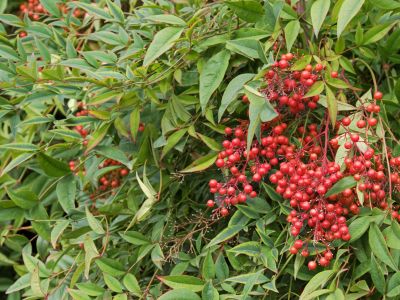Heavenly Bamboo Replacement
Nandina domestica can escape cultivation and outgrow native plants in the forest. It was once thought to be a great addition to the landscape, growing in many of your neighbor’s yards. It presents a constant battle with suckers and rhizomes to keep it under control. What are some good alternatives to heavenly bamboo? There are many Nandina alternatives. Native shrubs have great characteristics and won’t spread out of control. Their edible parts are good for most wildlife too.
What to Plant Instead of Nandina
Here are five plants to consider growing instead of heavenly bamboo.
Wax myrtle (Myrica cerifera) – This popular shrub stands up to many adverse conditions, including sea spray when planted near the beach. Wax myrtle has medicinal uses, as well as use in candle-making. Grow it in full sun to partial shade.
Florida anise (Illicium floridanum) – This often forgotten native has dark evergreen leaves in an elliptical shape with unusual, reddish star-shaped blooms. With fragrant foliage, this shrub grows in wet and marshy soils. Florida anise is dependable in the shade garden in USDA zones 7 through 10.
Grape holly (Mahonia spp.) – This interesting shrub grows in various areas. The Oregon grape variety is native to zones 5 to 9. Leaves grow in bundles of five to nine and are glossy spine-tipped leaflets. They emerge in spring with a lovely reddish bronze color, turning green by summer. Fragrant yellow flowers appear in late winter, becoming bluish black grape-like berries by summer that are eaten safely by birds. This flexible bush is an appropriate heavenly bamboo replacement.
Yaupon holly (Ilex vomitoria) – Growing in zones 7 to 10, the attractive yaupon holly bush can readily replace Nandina. The shrubs don’t get too big and offer a range of cultivars.
Juniper (Juniperus spp.) – Junipers are available in various sizes, shapes, and shades. They have evergreen foliage and berries that are safe for birds to eat. It is native to many places in the Northern Hemisphere.
